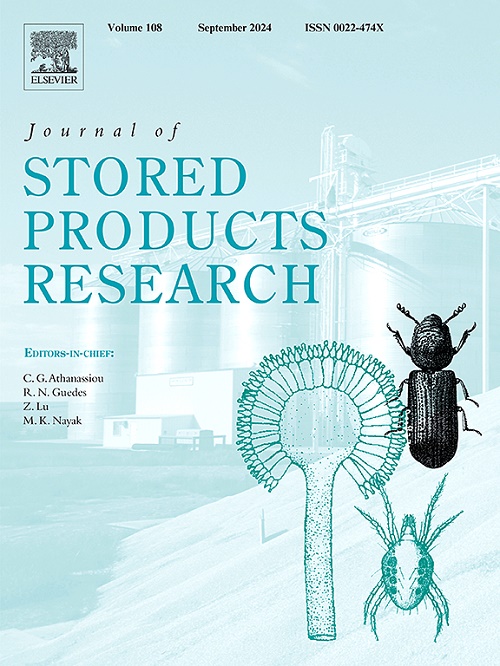Oxymatrine-based insecticide: A natural product for the control of stored-product beetle pests in wheat grain
IF 2.7
2区 农林科学
Q1 ENTOMOLOGY
引用次数: 0
Abstract
Insecticides of natural origin are a promising alternative to synthetic insecticides. Therefore, the intention of this study was to evaluate the potential of the natural product oxymatrine, as a wheat grain protectant against major stored-product beetle pests. The insecticidal activity of oxymatrine was tested against Rhyzopertha dominica (Fabricius, 1792) (Coleoptera: Bostrichidae), Sitophilus granarius (Linnaeus, 1758) (Coleoptera: Curculionidae), Sitophilus oryzae (Linnaeus, 1763) (Coleoptera: Curculionidae), Tribolium confusum (Jacquelin du Val, 1868) (Coleoptera: Tenebrionidae) and Tribolium castaneum (Herbst, 1797) (Coleoptera: Tenebrionidae) at doses of 0.25, 0.5, 1, 2 and 4 mg a.i./kg (ppm) of wheat grain. Initial mortality was assessed after 2, 7 and 14 days of exposure, and total mortality after 7 days of recovery period. The impact on progeny production/reduction was assessed for all species, while in the case of R. dominica and Sitophilus species related weight loss and frass production were also documented. The results show that species, dose, exposure and the recovery period significantly affect the effectiveness of oxymatrine. All doses of oxymatrine provided complete mortality of R. dominica after 7 days of exposure and 7 days of recovery. The satisfactory control of Sitophilus species and T. castaneum was achieved by 1 mg/kg and T. confusum by 4 mg/kg after 14 days of exposure and 7 days of recovery. Oxymatrine complete suppressed progeny production and prevented damage by R. dominica after all exposure intervals. The lowest number of progeny of Sitophilus and Tribolium species and damage by Sitophilus species was recorded after 14 days of exposure in wheat treated with ≥1 mg/kg of oxymatrine. The obtained results indicate that oxymatrine could be an efficient natural product for the control of stored-product beetles in stored wheat.
氧化苦参碱类杀虫剂:一种用于控制小麦谷物中储藏产品甲虫害虫的天然产品
天然杀虫剂是替代合成杀虫剂的一种很有前途的方法。因此,本研究旨在评估天然产品氧化苦参碱作为小麦谷物保护剂对主要储藏产品甲虫害虫的潜在作用。测试了氧化苦参碱对 Rhyzopertha dominica (Fabricius, 1792) (Coleoptera: Bostrichidae)、Sitophilus granarius (Linnaeus, 1758) (Coleoptera. Curculionidae)、Sitophilus granarius (Linnaeus, 1758) 和 Rhyzopertha dominica (Fabricius, 1792) 的杀虫活性:蟋蟀科)、Sitophilus oryzae (Linnaeus, 1763) (鞘翅目:蟋蟀科)、Tribolium confusum (Jacquelin du Val, 1868) (鞘翅目:天牛科)和 Tribolium castaneum (Herbst, 1797) (鞘翅目:天牛科)。25、0.5、1、2 和 4 毫克活性成分/千克麦粒(ppm)。暴露 2、7 和 14 天后评估初始死亡率,7 天恢复期后评估总死亡率。评估了所有物种对后代产量/减产的影响,同时还记录了主褐飞虱和嗜坐果蝇物种的相关体重减轻和虫粪产量。结果表明,物种、剂量、接触和恢复期对氧化苦参碱的效果有显著影响。所有剂量的氧化苦参碱在接触 7 天和恢复 7 天后都能完全杀死 R. dominica。在暴露 14 天和恢复 7 天后,1 毫克/千克的氧化苦参碱对 Sitophilus 和 T. castaneum 的控制效果令人满意,4 毫克/千克的氧化苦参碱对 T. confusum 的控制效果令人满意。氧化苦参碱可完全抑制后代的产生,并在所有接触间隔期内防止多角瘤蚜的危害。小麦接触≥1 毫克/千克氧化苦参碱 14 天后,Sitophilus 和 Tribolium 种的后代数量和 Sitophilus 种的危害最低。研究结果表明,氧化苦参碱是一种有效的天然产品,可用于控制储藏小麦中的储藏产品甲虫。
本文章由计算机程序翻译,如有差异,请以英文原文为准。
求助全文
约1分钟内获得全文
求助全文
来源期刊
CiteScore
5.70
自引率
18.50%
发文量
112
审稿时长
45 days
期刊介绍:
The Journal of Stored Products Research provides an international medium for the publication of both reviews and original results from laboratory and field studies on the preservation and safety of stored products, notably food stocks, covering storage-related problems from the producer through the supply chain to the consumer. Stored products are characterised by having relatively low moisture content and include raw and semi-processed foods, animal feedstuffs, and a range of other durable items, including materials such as clothing or museum artefacts.

 求助内容:
求助内容: 应助结果提醒方式:
应助结果提醒方式:


